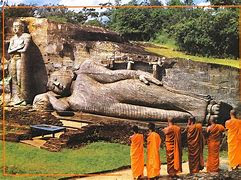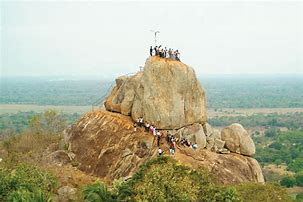EMBEKKE
Where is it situated?
Embekke Devalaya is situated in Medapalata Korale of Udunuwara in Kandy District. This is a sheltered place used to rest during long pilgrimage or long journeys in ancient days of Sri Lanka. This Ambalama is said to be built during AD 1341–1357 by the King Bhuwanekabahu.
Wood carvings of Embekke Devalaya
The most noticeable feature of the Embekke Devalaya is the carvings on the wooden pillars. There are various images carved into the sides of these pillars. The specialty of these carvings is each of them is different from one another. When we consider the carvings of the entire Devala complex, there are about 125 series of decorations, 256 festoon type designs, and 64 lotus designs, 30 decorative patterns, and roof designs. Thus, there are altogether 514 unique designs.
Out of these famous wood carvings, one of the most recognizable carvings is the Hansa Puttuwa, or entwined Swans. Others include designs of entwined rope (Lanu Gataya), sneezing face (Kisimbi Muna), festoon work (Liyawala), images of Deities (Deva Ruwa), hawk (Gijulihiniya) along with double-headed Eagles, dancing female forms, a mother breastfeeding child, wrestlers, soldiers fighting on horseback, birds with human figures and many more. One of the most unique carvings features an entwined elephant and bull. Here, covering the bull carving with ones hand reveals the whole elephant, and covering the elephant likewise reveals the bull. It is an amazing example of the artistic expertise of Sri Lankan forefathers.
Architectural features of the Embekke Devalaya
The Embekke Devalaya provides an insightful display of the architecture adopted in ancient Sri Lanka. This construction consists of three main sections as the sanctum or Garbhaya in which the image of the God Kataragama has been housed, the Digge or Dancing hall) which is representative of the king consort Henakanda Bandara, and where dancing events were held in the times of the kings and also the final section is the Drummers’ Hall or Hewisi Mandapaya, representing the drummer Rangama who is involved with the back story of its construction and where musical events were once held.
Conclusion
Except for the Sanctum, the rest of the Embekke Devalaya is made almost entirely of wood presenting a breathtaking view for the visitors. The most significant place in this Devalaya complex is the Drummer’s hall due to its architectural features adorned with splendid wood carvings on pillars and doorframes. The building is 52 feet long and 25 feet wide and it is raised with the support of 32 wooden pillars. It is also built on a granite base about 34 inches high.

























